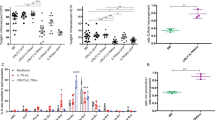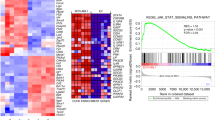Abstract
The Abl kinase inhibitor imatinib mesylate is the preferred treatment for Philadelphia chromosome–positive (Ph+) chronic myeloid leukemia (CML) in chronic phase but is much less effective in CML blast crisis or Ph+ B-cell acute lymphoblastic leukemia (B-ALL). Here, we show that Bcr-Abl activated the Src kinases Lyn, Hck and Fgr in B-lymphoid cells. BCR-ABL1 retrovirus-transduced marrow from mice lacking all three Src kinases efficiently induced CML but not B-ALL in recipients. The kinase inhibitor CGP76030 impaired the proliferation of B-lymphoid cells expressing Bcr-Abl in vitro and prolonged survival of mice with B-ALL but not CML. The combination of CGP76030 and imatinib was superior to imatinib alone in this regard. The biochemical target of CGP76030 in leukemia cells was Src kinases, not Bcr-Abl. These results implicate Src family kinases as therapeutic targets in Ph+ B-ALL and suggest that simultaneous inhibition of Src and Bcr-Abl kinases may benefit individuals with Ph+ acute leukemia.
This is a preview of subscription content, access via your institution
Access options
Subscribe to this journal
Receive 12 print issues and online access
$209.00 per year
only $17.42 per issue
Buy this article
- Purchase on SpringerLink
- Instant access to full article PDF
Prices may be subject to local taxes which are calculated during checkout







Similar content being viewed by others
References
Sawyers, C.L. Chronic myeloid leukemia. N. Engl. J. Med. 340, 1330–1340 (1999).
Druker, B.J. et al. Activity of a specific inhibitor of the BCR-ABL tyrosine kinase in the blast crisis of chronic myeloid leukemia and acute lymphoblastic leukemia with the Philadelphia chromosome. N. Engl. J. Med. 344, 1038–1042 (2001).
Kantarjian, H. et al. Hematologic and cytogenetic responses to imatinib mesylate in chronic myelogenous leukemia. N. Engl. J. Med. 346, 645–652 (2002).
Gorre, M.E. et al. Clinical resistance to STI-571 cancer therapy caused by BCR-ABL1 gene mutation or amplification. Science 293, 876–880 (2001).
Branford, S. et al. High frequency of point mutations clustered within the adenosine triphosphate-binding region of BCR/ABL in patients with chronic myeloid leukemia or Ph-positive acute lymphoblastic leukemia who develop imatinib (STI571) resistance. Blood 99, 3472–3475 (2002).
Roumiantsev, S. et al. Clinical resistance to the kinase inhibitor STI-571 in CML by mutation of Tyr253 in the Abl kinase domain P-loop. Proc. Natl. Acad. Sci. USA 99, 10700–10705 (2002).
Shah, N.P. et al. Multiple BCR-ABL kinase domain mutations confer polyclonal resistance to the tyrosine kinase imatinib (STI571) in chronic phase and blast crisis chronic myeloid leukemia. Cancer Cell 2, 117–125 (2002).
Sattler, M. & Griffin, J.D. Molecular mechanisms of transformation by the BCR-ABL oncogene. Semin. Hematol. 40, 4–10 (2003).
Danhauser-Riedl, S., Warmuth, M., Druker, B.J., Emmerich, B. & Hallek, M. Activation of Src kinases p53/56Lyn and p59Hck by p210Bcr/Abl in myeloid cells. Cancer Res. 56, 3589–3596 (1996).
Warmuth, M. et al. The Src family kinase Hck interacts with Bcr-Abl by a kinase-independent mechanism and phosphorylates the Grb2-binding site of Bcr. J. Biol. Chem. 272, 33260–33270 (1997).
Klejman, A. et al. The Src family kinase Hck couples BCR/ABL to STAT5 activation in myeloid leukemia cells. EMBO J. 21, 5766–5774 (2002).
Stanglmaier, M., Warmuth, M., Kleinlein, I., Reis, S. & Hallek, M. The interaction of the Bcr-Abl tyrosine kinase with the Src kinase Hck is mediated by multiple binding domains. Leukemia 17, 283–289 (2003).
Lionberger, J.M., Wilson, M.B. & Smithgall, T.E. Transformation of myeloid leukemia cells to cytokine independence by Bcr-Abl is suppressed by kinase-defective Hck. J. Biol. Chem. 275, 18581–18585 (2000).
Wilson, M.B., Schreiner, S.J., Choi, H.J., Kamens, J. & Smithgall, T.E. Selective pyrrolo-pyrimidine inhibitors reveal a necessary role for Src family kinases in Bcr-Abl signal transduction and oncogenesis. Oncogene 21, 8075–8088 (2002).
Warmuth, M. et al. Dual-specific Src and Abl kinase inhibitors, PP1 and CGP76030, inhibit growth and survival of cells expressing imatinib mesylate-resistant Bcr-Abl kinases. Blood 101, 664–672 (2003).
Van Etten, R.A. Studying the pathogenesis of BCR-ABL+ leukemia in mice. Oncogene 21, 8643–8651 (2002).
Li, S., Ilaria, R.L., Million, R.P., Daley, G.Q. & Van Etten, R.A. The P190, P210, and P230 forms of the BCR/ABL oncogene induce a similar chronic myeloid leukemia-like syndrome in mice but have different lymphoid leukemogenic activity. J. Exp. Med. 189, 1399–1412 (1999).
Roumiantsev, S., de Aos, I., Varticovski, L., Ilaria, R.L. & Van Etten, R.A. The Src homology 2 domain of Bcr/Abl is required for efficient induction of chronic myeloid leukemia-like disease in mice but not for lymphoid leukemogenesis or activation of phosphatidylinositol 3-kinase. Blood 97, 4–13 (2001).
Li, S. et al. Interleukin-3 and granulocyte-macrophage colony-stimulating factor are not required for induction of chronic myeloid leukemia-like myeloproliferative disease in mice by BCR/ABL . Blood 97, 1442–1450 (2001).
Chan, V.W., Meng, F., Soriano, P., DeFranco, A.L. & Lowell, C.A. Characterization of the B lymphocyte populations in Lyn-deficient mice and the role of Lyn in signal initiation and down-regulation. Immunity 7, 69–81 (1997).
McLaughlin, J., Chianese, E. & Witte, O.N. In vitro transformation of immature hematopoietic cells by the P210 bcr/abl oncogene product of the Philadelphia chromosome. Proc. Natl. Acad. Sci. USA 84, 6558–6562 (1987).
Smith, K.M., Yacobi, R. & Van Etten, R.A. Autoinhibition of Bcr-Abl through its SH3 domain. Mol. Cell 12, 27–37 (2003).
Wolff, N.C. & Ilaria, R.L. Jr. Establishment of a murine model for therapy-treated chronic myelogenous leukemia using the tyrosine kinase inhibitor STI571. Blood 98, 2808–2816 (2001).
Hoover, R.R., Mahon, F.-X., Melo, J.V. & Daley, G.Q. Overcoming STI571 resistance with the farnesyltransferase inhibitor SCH66336. Blood 100, 1068–1071 (2002).
Klejman, A., Rushen, L., Morrione, A., Slupianek, A. & Skorski, T. Phosphatidylinositol 3-kinase inhibitors enhance the anti-leukemic effect of STI571. Oncogene 21, 5868–5876 (2002).
Goga, A., McLaughlin, J., Afar, D.E., Saffran, D.C. & Witte, O.N. Alternative signals to RAS for hematopoietic transformation by the BCR-ABL oncogene. Cell 82, 981–988 (1995).
Million, R.P. & Van Etten, R.A. The Grb2 binding site is required for induction of chronic myeloid leukemia-like disease in mice by the Bcr/Abl tyrosine kinase. Blood 96, 664–670 (2000).
Meng, F. & Lowell, C.A. Lipopolysaccharide (LPS)-induced macrophage activation and signal transduction in the absence of Src-family kinases Hck, Fgr, and Lyn. J. Exp. Med. 185, 1661–1670 (1997).
He, Y. et al. The coiled-coil domain and Tyr177 of bcr are required to induce a murine chronic myelogenous leukemia-like disease by bcr/abl. Blood 99, 2957–2968 (2002).
Dash, A.B. et al. A murine model of CML blast crisis induced by cooperation between BCR/ABL and NUP98/HOX49 . Proc. Natl. Acad. Sci. USA 99, 7622–7627 (2002).
Cuenco, G.M. & Ren, R. Cooperation of BCR-ABL and AML1/MDS1/EVI1 in blocking myeloid differentiation and rapid induction of an acute myelogenous leukemia. Oncogene 20, 8236–8248 (2001).
La Rosee, P., Corbin, A.S., Stoffregen, E.P., Deininger, M.W. & Druker, B.J. Activity of the Bcr-Abl kinase inhibitor PD180970 against clinically relevant Bcr-Abl isoforms that cause resistance to imatinib mesylate (Gleevec, STI571). Cancer Res. 62, 7149–7153 (2002).
Donato, N.J. et al. BCR-ABL independence and LYN kinase overexpression in chronic myelogenous leukemia cells selected for resistance to STI571. Blood 101, 690–698 (2003).
Sexl, V. et al. Stat5a/b contribute to interleukin 7-induced B-cell precursor expansion, but abl- and bcr/abl-induced transformation are independent of STAT5. Blood 96, 2277–2283 (2000).
Tauchi, T. et al. SH2-containing phosphotyrosine phosphatase Syp is a target of p210bcr-abl tyrosine kinase. J. Biol. Chem. 269, 15381–15387 (1994).
Daigle, I., Yousefi, S., Colonna, M., Green, D.R. & Simon, H.U. Death receptors bind SHP-1 and block cytokine-induced anti-apoptotic signaling in neutrophils. Nat. Med. 8, 61–67 (2002).
Yang, W. et al. SHP-1 deficiency in B-lineage cells is associated with heightened lyn protein expression and increased Lyn kinase activity. Exp. Hematol. 26, 1126–1132 (1998).
Li, S., Couvillon, A.D., Brasher, B.B. & Van Etten, R.A. Tyrosine phosphorylation of Grb2 by Bcr/Abl and epidermal growth factor receptor: a novel regulatory mechanism for tyrosine kinase signaling. EMBO J. 20, 6793–6804 (2001).
Pear, W.S. et al. Efficient and rapid induction of a chronic myelogenous leukemia-like myeloproliferative disease in mice receiving P210 bcr/abl-transduced bone marrow. Blood 92, 3780–3792 (1998).
Finer, M.H., Dull, T.J., Qin, L., Farson, D. & Roberts, M. kat: A high-efficiency retroviral transduction system for primary human T lymphocytes. Blood 83, 43–50 (1994).
Acknowledgements
We thank C. Lowell for Lyn−/− Hck−/− Fgr−/− mice; A. Wood and P. Lassota for discussions; K. Paigen, B. Tennent and S. Sampson for critically reading the manuscript; and P. Cherry for the secretarial assistance. This work was supported by the institutional funds from The Jackson Laboratory and grants from the Irving A. Hansen Foundation and The V Foundation for Cancer Research to S.L., who is a Scholar of The V Foundation for Cancer Research, and by a grant from the US National Institutes of Health and a Leukemia and Lymphoma Society SCOR grant to R.A.V., who is a Stohlman Scholar of the Leukemia and Lymphoma Society.
Author information
Authors and Affiliations
Corresponding author
Ethics declarations
Competing interests
The authors declare no competing financial interests.
Supplementary information
Rights and permissions
About this article
Cite this article
Hu, Y., Liu, Y., Pelletier, S. et al. Requirement of Src kinases Lyn, Hck and Fgr for BCR-ABL1-induced B-lymphoblastic leukemia but not chronic myeloid leukemia. Nat Genet 36, 453–461 (2004). https://doi.org/10.1038/ng1343
Received:
Accepted:
Published:
Issue Date:
DOI: https://doi.org/10.1038/ng1343



